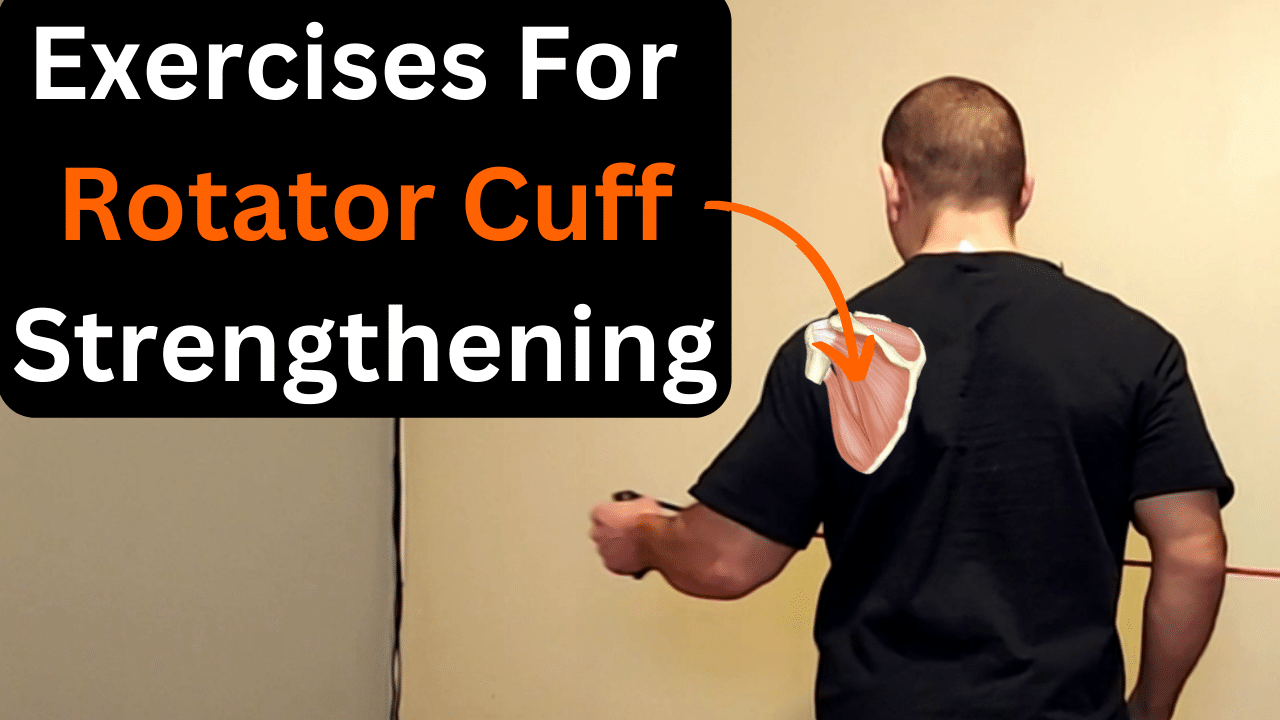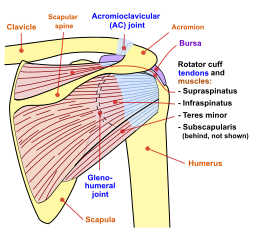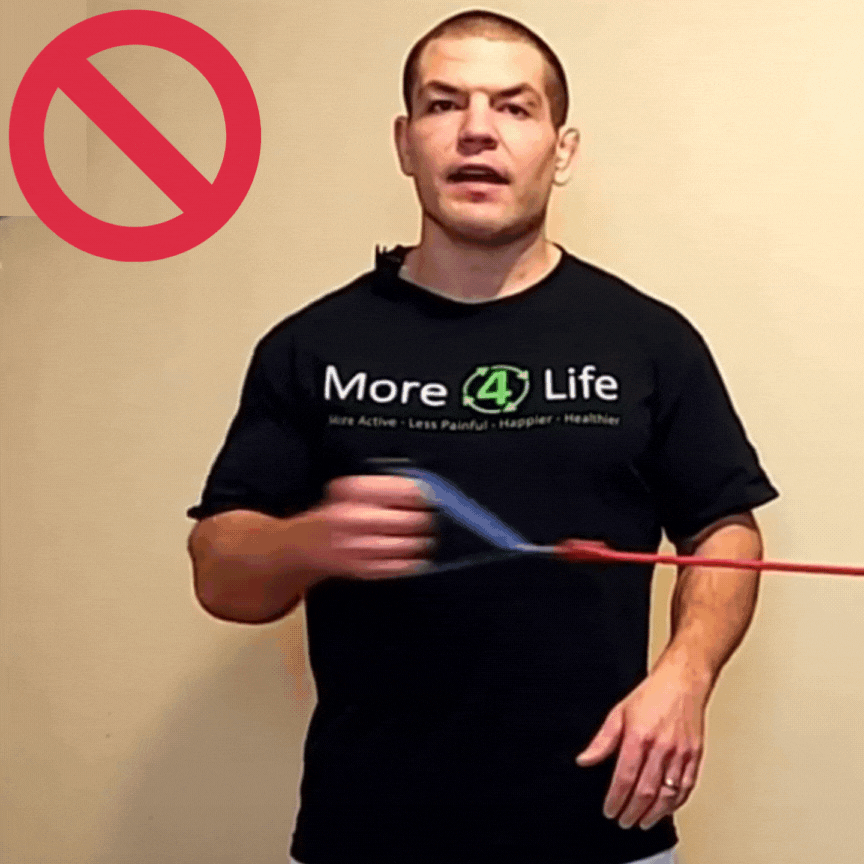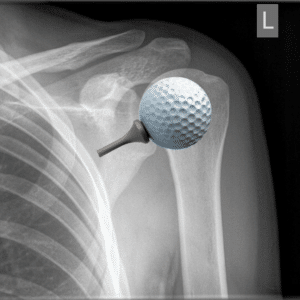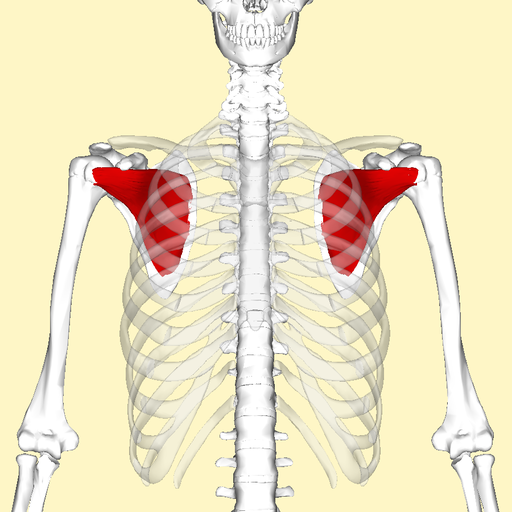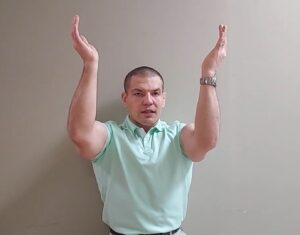What Are The Best Exercises For Rotator Cuff Strengthening?
Watch the video to learn 8 exercises for rotator cuff strengthening, plus common mistakes to avoid.

The Most Common Exercises For Rotator Cuff Strengthening Aren't The Best
The most common exercises for rotator cuff strengthening involve using rubber tubing or a resistance band and turning your arm inward and outward.
These motions are called internal rotation and external rotation.
Three of your rotator cuff muscles are shoulder external rotators (supraspinatus, infraspinatus, and teres minor). One muscle, the subscapularis, is a shoulder internal rotator.
So on the surface, it would make sense to do these type of exercises to strengthen your rotator cuff.
However, there are a few problems with these type of rotator cuff strengthening exercises.
- They don't represent the way you use your rotator cuff muscles in everyday life.
- Many people do them wrong.
First I'll go over the common mistakes that people make when doing these "traditional" exercises for rotator cuff strengthening.
Then later in this post, I'll explain some more functional exercises that strengthen your rotator cuff in the way that you actually use it.
Common Mistakes With Rotator Cuff Strengthening Exercises
By far, the most common exercises people perform for their rotator cuff are internal and external rotation with a resistance band.
So let's take a look at these exercises and break down some common mistakes people make when they're doing shoulder external and internal rotation
Shoulder External Rotation With Resistance Band
When most people do this exercise, they move their arm in internal and external rotation too quickly and allow their shoulder blade to get involved in the movement.
However, your rotator cuff muscles attach from your shoulder blade to her arm bone (humerus). Therefore, your rotator cuff muscles shouldn't move your shoulder blade.
If you shoulder blade is moving, then you're using other muscles such as your rhomboids to substitute for your rotator cuff muscles.
Many people with shoulder pain have rhomboids that are overactive anyway. Therefore, when you use your rhomboids, you're strengthening what's already too strong and dominant and NOT strengthening your rotator cuff.
Instead, you want to go at a slow controlled speed. Imagine a golf ball sitting on a golf tee, where your shoulder "socket" is the tee, and the golf ball is your humeral head.
You want to rotate that ball in the center of the tee without allowing the tee to move.
When you move your arm in a slow, controlled manner, you'll notice that the range of motion is significantly less when doing it this way versus allowing your shoulder blade to get involved in he movement.
And that's OK! (Good even)
Again, it's more important to use the correct muscles than how fast or far you move your arm.
Use A Towel Under Your Elbow
Another tip is to take a towel and roll it up in a log. Then put the towel between your elbow and your body.
This helps keep your shoulder in its normal, anatomical position, which is slightly out to the side and slightly in front of the body.
Additionally, doing this helps prevent your supraspinatus from being overstretched over the ball of the shoulder.
Shoulder Internal Rotation With Resistance Band
This exercise is meant to strengthen the subscapularis muscle. The subscapularis lies underneath the shoulder blade between your ribcage and your shoulder blade.
Because of that, it's often "out of site out of mind". However, a lot of people with shoulder pain do have trigger points in their suscapularis.
In the clinic we treat those with manual therapy trigger point therapy and dry needling.
The subscapularis rotates the arm (humerus) inward.
However, it's common for people to use their chest muscles to internally rotate the shoulder blade (scapula) instead.
Just like with shoulder external rotation, it often helps to use a towel under the elbow and moving in a slower and controlled motion.
Most Common Doesn't Mean Best
So those are the correct ways to perform the most common rotator cuff strengthening exercises, but again, I don't think those are necessarily the BEST rotator cuff exercises.
if you look at studies, they do produce a lot of EMG activation of the rotator cuff. That's basically an electrical study that measures how much the muscle activate.
And although external and internal rotation exercises are really good exercises for activating rotator cuff muscles, that doesn't necessarily translate into better function and less pain.
Why is that?
Because most of the time we don't use our rotator cuff in this sort of manner. We don't often move our arm into internal and external rotation with our elbow at our side in everyday life.
Furthermore, when people do have shoulder pain, they typically have problems when they're reaching above shoulder level, throwing things, or reaching out to the side.
So why not do your rotator cuff strengthening exercises in that position?
Better Exercises For Rotator Cuff Strengthening
Since most shoulder problems occur when your arm is above shoulder level, you want to strengthen your rotator cuff with your arm above your shoulder level as well.
Doing external and internal rotation exercises with your arm above shoulder level is one way to do that.
You can do that in several ways:
- Rotate your arm back and forth with your elbow at shoulder level trying to spin your forearm around your arm. Try to keep your elbow as still as possible. to increase the difficulty, increase the speed of movement while still maintaining good arm control.
- Use a dumbbell as resistance while performing external and internal rotation as noted above.
- Use a dumbbell as resistance while performing external and internal rotation as noted above.
This type of exercise is good for pitchers, swimmers, and other athletes who participate in overhead sports and need to be able to rotate their arm above shoulder level.
However, for people who aren't overhead athletes, that exercise isn't particularly functional either.
What Are The Best Exercises For Rotator Cuff Strengthening?
To understand this, keep in mind is that your rotator cuff really has two functions:
- It's prime mover function is to rotate your arm as in the exercises above.
- However, it has a secondary function to stabilize the shoulder as you're moving your arm.
The latter of these two is really how we use our rotator cuff muscle the most in everyday life.
Think back to the analogy of a golf ball sitting on a golf tee that I mentioned earlier.
The rotator cuff functioned to keep the ball centered on the "tee" or centered in the shoulder socket as you move your arm to lift or reach for things.
In order to strengthen your rotator cuff in it's stabilizer function, the best exercises to facilitate that are just reaching or lifting overhead.
Here 3 Functional Exercises For Rotator Cuff Strengthening:
- Raise your arms out to the side. Externally rotate your arms so that your wrists are above or slightly behind your elbows. Raise your arms over your head, ONLY as far as you can maintaining the external rotation. Repeat 10 times. This exercise strengthens your rotator cuff while also stretching your pectoral muscles.
- Add weight to the exercise above to turn the exercise into shoulder press.
- Stand with your back to the wall and raise your arms out in front of you with your elbows bent 90 degrees. Makes sure your forearms are vertical and parallel with each other. This will ensure that you're externally rotating your arms. Raise your arms overhead in front of you, ONLY as far as you can keeping your forearms parallel. Repeat 10 reps. This exercise not only strengthens your rotator cuff, but also stretches your latissimus dorsi muscle. See our post on How To Stretch Your Lat Dorsi for more details on this exercise.
Conclusion
So those are the 8 exercises for rotator cuff strengthening:
- 2 typical rotator cuff strengthening exercises with a resistance band
- 3 internal and external rotation exercises above shoulder level for throwing atheltes
- 3 functional, everyday strengthening exercises for anyone with shoulder pain
However, just strengthening your rotator cuff muscles alone WON'T likely fix your shoulder pain. To get lasting relieve from shoulder pain, you need to find the root cause of the problem. This may include things like bad posture, poor movement patterns, or possibly even a pinched nerve in your neck.
If you'd like to discover what's causing your shoulder pain and how you can stop it for good, tap the button below to request a Free Discovery Visit with one of our specialists.

